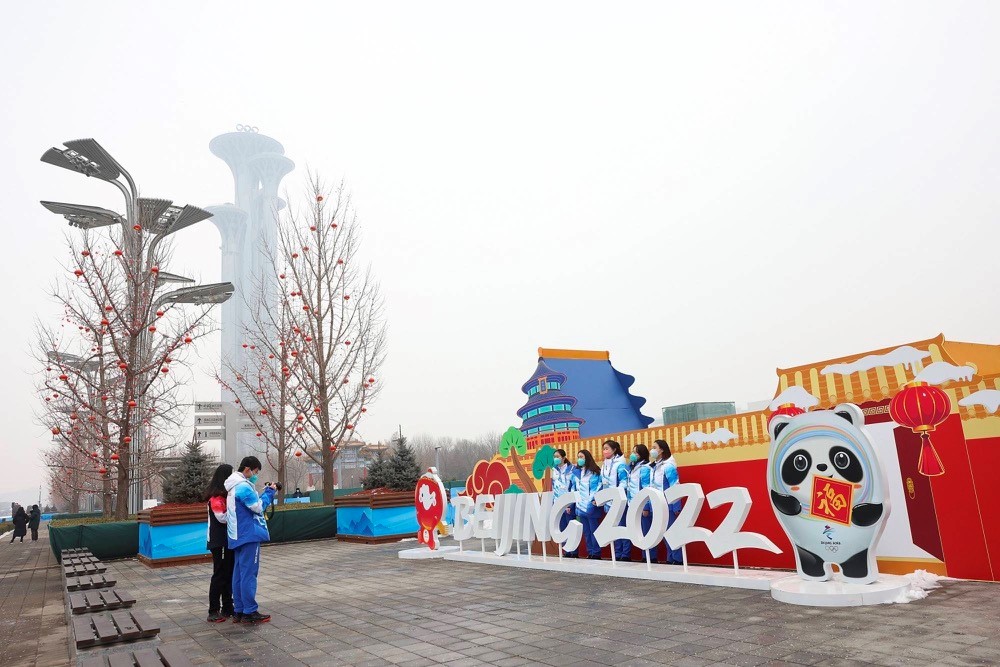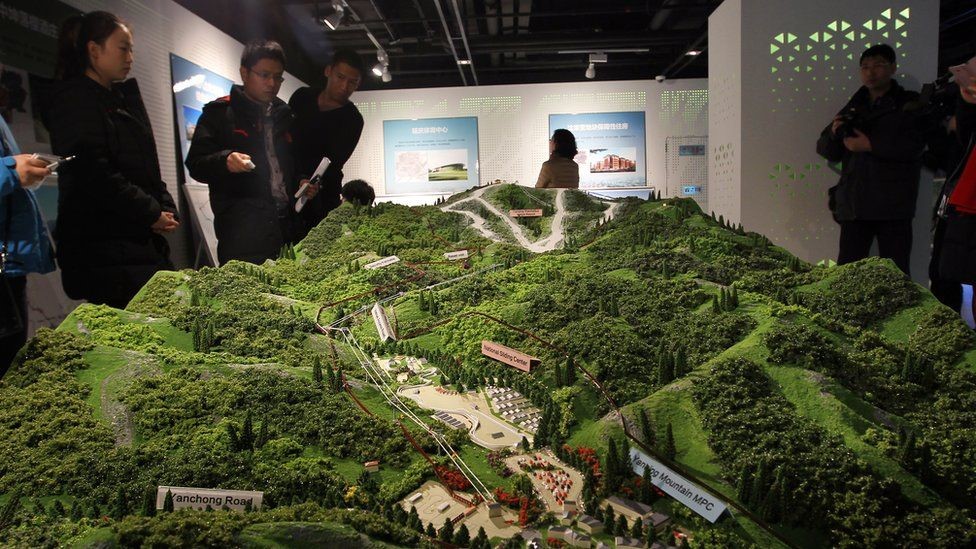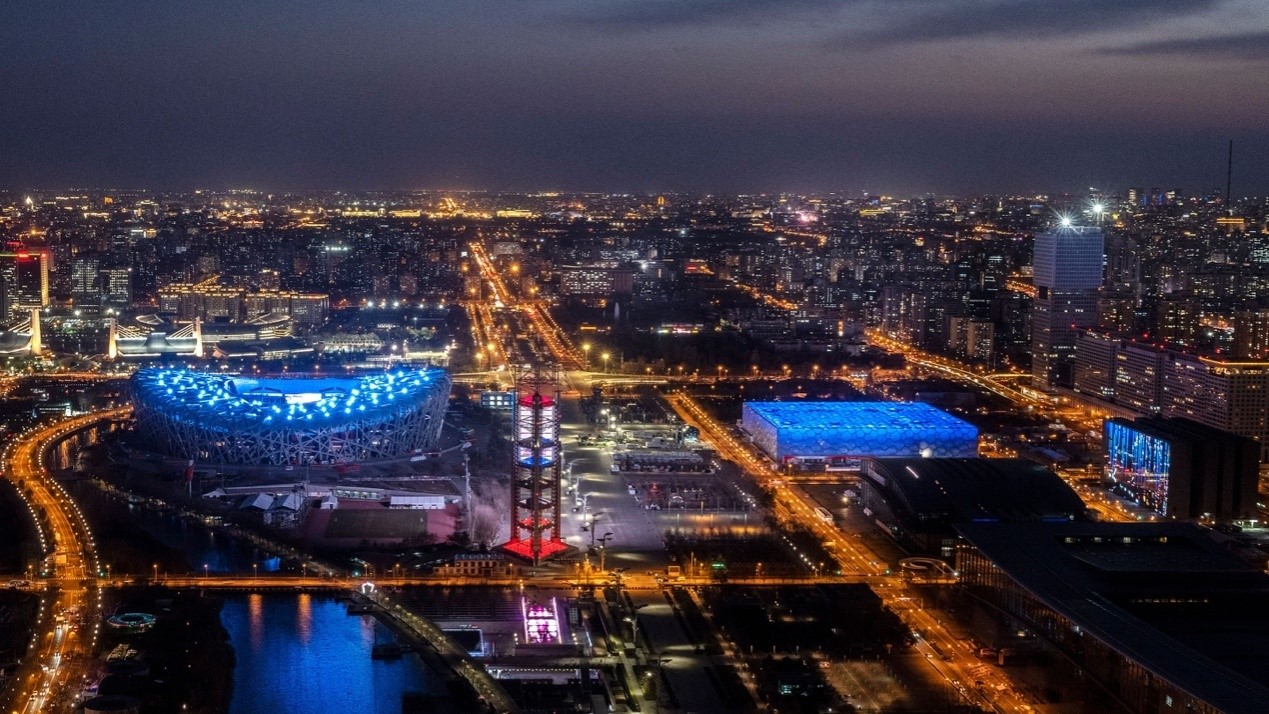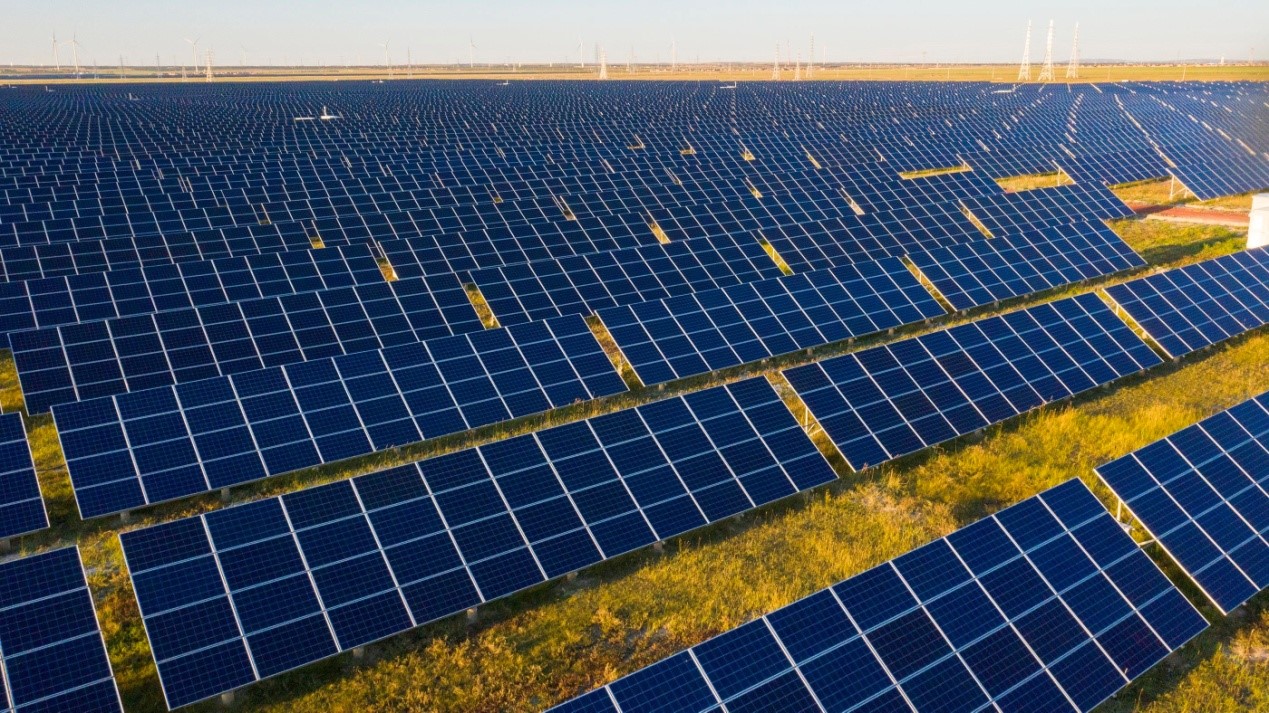2021年12月初,美国曾扬言“不派任何官方代表”出席北京冬奥会,并怂恿部分西方盟友做出同样举动。随后2021年12月27日,经外交部证实,中方已收到来自美国务院和国防部18名官员的赴华签证申请,拜登政府闹出来的“外交抵制”戏码成了彻头彻尾的笑话。西方政界和学者对于美国政府这种“两面派”的行为发表了各自的看法。

(图片来源:Bloomberg)
一、冬奥会全部场馆100%使用”绿电”,包括数千块太阳能电池板、数千个风力涡轮机、数百公里的高压输电线和世界上最大的电池。整个绿电系统预计每年可向首都输送140亿千瓦时的低碳电力,约占北京总消耗量的10%。冬奥会促进北京低碳转型,是中国可再生能源蓝图的一个缩影。中国计划到2030年具备充足的太阳能和风能发电能力,能产生1200吉瓦的电力——相当于美国的所有电力需求。
In June 2019, China published the “CarbonManagement Plan for the Olympic and Paralympic Winter Games Beijing 2022,”focusing on energy, construction, transportation, and carbon sinks. Leadershipoften uses major events as deadlines, and for the Beijing Winter Olympics,China’s dual motivation is to guide the Chinese public to low-carbon practicesand to spotlight China’s commitment to achieve carbon peaks by 2030 and carbonneutrality by 2060.
All of the 26 Winter Olympic venuesare powered with 100 percent renewable energy. For example, the YanqingMountain News Center has a photovoltaic power generation system; the YanqingWinter Olympics Village uses high-voltage electrode boilers for heating; and,as a first in Winter Olympic history, ice-making will use carbon dioxide as arefrigerant, not ozone layer-harming freon, increasing ice-making efficiency byabout 30 percent and cutting emissions to nearly zero. AI is used to savewater.
For green transportation at theOlympics, the proportion of new energy vehicles is the highest ever, accountingfor 100 percent of passenger cars and 86 percent of all vehicles. (For greentransportation in Beijing, the “135” green low-carbon travel initiative waslaunched — that is, walk within 1 km, ride a bicycle within 3 km, and takegreen low-carbon public transport within 5 km.)
By optimizing and integrating multiplegreen technologies, Olympics venues are expected to consume about 400 millionkWh of green electricity, which would cut 128,000 tons of standard coalcombustion and 320,000 tons of carbon dioxide.
The Beijing Winter Olympics is atest bed for new green technologies, such that this grand event can serve alsoas a pilot program for the kind of sustainable development that our planetneeds to combat climate change.
(Jan. 25, 2022, CGTN, How is the Beijing Winter Olympics green?)
The organisers wanted the BeijingWinter Olympics to be the “first carbon-neutral Games”. China has set anambitious goal of delivering the games using 100% renewable energy.
Over six years, the organisers havebeen constructing new wind and solar projects to deliver enough clean energy,not just for the Games, but for the whole of Beijing.
If you take the government figurefor the amount of coal saved, this could avoid 12.9 million tonnes of CO2emissions annually.
(Jan. 26, 2022, CNN , Winter Olympics: Will the Beijing Games be ‘green and clean’?)
“We are very confident that we willbe a truly carbon-neutral games,” says Liu Xinping, who is in charge ofsustainability for the Beijing Organising Committee for the 2022 Olympic andParalympic Winter Games. Offsets greater than the games’ likely footprint havealso been secured, Liu adds.
Previous Winter Olympics haveclaimed to be carbon neutral, but the International Olympics Committee (IOC)says that China is considering a much broader range of emissions. It hasalready been investing heavily in renewable energy as part of its overall goalof achieving carbon neutrality by 2060.
The games’ estimated footprint,equivalent to 1.3 million tonnes of carbon dioxide, is a drop in the oceancompared with China’s annual emissions of about 11 billion tonnes, but thevalue of its achievement is “in demonstrating that broader carbon-neutralactivities are possible”, says Michael Davidson, an energy systems researcherat the University of California San Diego.
(Feb. 4, 2022, Nature, China’s Winter Olympics are carbon-neutral — how?)
The flexible DC grid put into placein Zhangjiakou in 2020 will let 22.5 billion kilowatt-hours of wind and solarenergy flow from Zhangjiakou to Beijing every year. By the time the Paralympicsend in March, the game venues are expected to have consumed about 400 millionkWh of electricity. If all of it is indeed provided by renewables, that shouldreduce carbon emissions by 320,000 tonnes, according to sports outlet Insidethe Games. After the athletes go home, the flexible DC grid will continue toclean up around 10 percent of the capital’s immense electricity consumption.
Green transport infrastructurebeing built to shuttle athletes and spectators between venues will also be partof the games’ lasting legacy. A clean energy–powered high-speed railway thattakes 47 minutes to travel between Beijing and Zhangjiakou was inaugurated in2019. More than 85 percent of public-transport vehicles at the Olympics will bepowered by batteries, hydrogen fuel cells, or natural gas, according to statemedia.
In August, officials at the Chinesecapital revealed a five-year hydrogen-energy plan, with goals to build 37fueling stations and have about 3,000 fuel-cell vehicles on the road by 2023,for which the Olympics should also be a stepping-stone. Already, hydrogenfueling stations built by China’s petrochemical giant Sinopec,Pennsylvania-based Air Products, and French company Air Liquide have cropped upin Beijing, Zhangjiakou, and the Yanqing competition zone located in between.
In Yanqing alone, 212 fuel-cellbuses made by Beijing-based BeiqiFoton Motor Co. will shuttle spectatorsaround. Even the iconic Olympic torch will burn hydrogen for its flame.
(Dec. 29, 2021, IEEE Spectrum , China Will Attempt First Carbon-Neutral Winter Olympics)

(图片来源:GettyImages)
二、北京是首个大规模使用当今最环保的二氧化碳制冰技术的冬奥会主办城市。相比氟利昂,北京冬奥会的二氧化碳冷却技术使制冰能源效率提高了30%。
Another Olympics-linked innovationis the use of carbon dioxide as a cooling agent instead of Freon to make ice,making it the first host city in the history of the Olympics to use this kindof technology. The ice-making process is 30% more energy efficient, state newsagency Xinhua said in May last year.
Five of the nine Olympics ice rinkswill use natural carbon dioxide, which is more ozone-friendly and has a muchsmaller effect on global warming than the refrigerant organizers initiallyconsidered, according to Xinhua. For comparison, organizers of the PyeongchangGames in 2018 pledged to make it the first zero-emissions event in Olympicshistory, but the hydrofluorocarbon (HFC) refrigerant that was used in all ofits ice arenas is 3,922 times more potent in warming the climate than carbondioxide.
“In the past years, airconditioning has grown fast in China. And the country hasn’t phased out itsfluorinated gases yet so emissions have grown very fast,” said Myllyvirta. “Thatis a kind of technology that can make a big difference,” he added.
(Jan. 25, 2022, Bloomberg, Winter Olympics to Test China’s Commitments to Climate Change)
“Experts from internationalfederations told us that common eco-friendly ice-making practices at theNational Speed Skating Oval would meet Olympic standards. But we spent 18months studying ice-making from previous Winter Olympic Games and analyzing thepros and cons of every type of refrigerant. Eventually, we were able to come upwith better solutions,” said Song Jiafeng, an engineer with the venue’sconstruction team.
According to Song, using carbondioxide as a refrigerant can increase ice-making efficiency by 30 percent andsave around two million kilowatts of electricity per year.
The choice was applauded by theIOC, which “fully supports” the decision and its implementation.
“We thank you very much for yourdecision to use CO2 as the refrigerant for the National Speed Skating Oval. Youshall be commended for this important and responsible decision, that will be avery strong asset to support Beijing 2022 sustainability ambitions andcommitments as regards Olympic venue infrastructure,” wrote Pierre Ducrey in anemail to Beijing 2022 organizers.
(Jan. 20, 2021, China Daily,Eco-friendly innovation a realGames changer)

(图片来源:BBC)
三、北京冬奥会成为场馆再利用典范。北京2022年冬奥会最大程度使用了2008年的场馆遗产,对原有体育场馆的改造在建设过程中仍然保留了原有的使用功能,同时注入了新的冬季运动使用功能。同时,未来这些场馆不仅可以举办体育赛事,还可以进行娱乐文化活动,也可以作为训练场馆向公众开放。
Beijing renovated six venues thatwere used for the 2008 Games with recyclable material to make them compatiblefor both the upcoming Winter Games, as well as other events in the future,according to the organizing committee’s legacy plan announced in June, whichdetails how venues and other infrastructure will be managed once the Gamesfinish.
For example, the Beijing NationalAquatics Center, which served as the site for aquatics events in 2008, willhost curling events after a swimming pool was repurposed with a stiltstructure.
The plan also maps out a blueprintfor future use of the venues. The Zhangjiakou Zone, for example, where three ofthe four competition venues were built just for the Games, will turn into awinter entertainment center and summer holiday resort after the Olympics, whichis also in line with broader policy goals of developing winter sports in thecountry.
At the Pyeongchang Games, venuesincluding the “disposable” Olympic stadium, which cost approximately $60million to build, were torn down soon after the event.
(Jan. 25, 2022, Bloomberg, Winter Olympics to Test China’s Commitments to Climate Change)
The first city in the world to hostboth Summer and Winter Olympic Games (2008 and 2022), Beijing has been able toreuse many of its iconic sporting venues. Also for the first time in Olympichistory, all the venues are expected to be powered by renewable energy, whilenewly constructed venues are embracing new construction standards from waterand energy efficiency to building insulation and cooling technologies.
The venues are a vital part of theBeijing 2022 legacy, helping to drive the growth of winter sports and relatedbenefits for health and society, and to provide opportunities for economicdevelopment.
Five competition venues are beingreused from the Olympic Games in 2008. A core driver for this has been the IOC’sOlympic Agenda 2020, which requires host cities to minimise new constructionand thereby reduce carbon emissions, among other measures.
“By making full use of existingvenues and equipping them with innovative technologies, Beijing 2022 cutsemissions, reduces environmental impacts, and the consumption of water, energyand materials,” says Marie Sallois, IOC Director for Sustainability. “Many ofthe Beijing 2022 venues are designed with flexibility in mind to serve theathletes as well as the local population in a variety of ways and throughoutthe whole year.”
(Jan. 27, 2022International Olympic Committee, Beijing 2022 venues: reusing, reducing and modernising)

(图片来源:GettyImages)
四、北京冬奥会高科技属性日益彰显,冬奥村里的智能设备、运动员的智能家居生活、赛场上的智慧医疗服务,以及氢能火炬传递,无不展示了科技奥运、绿色奥运的中国答卷。
The Beijing Games are filled withconventionality — intricate Olympic ceremonies, torch lightings, well-designeduniforms and of course, a full 15-sport coverage throughout the three-weekcontest. However, China is also showing the evolution of the Games throughindustrial innovation — the robotic figurines serving meals to Olympicparticipants.
In efforts to minimizeperson-to-person contact, meal venues resemble sci-fi movie junctures.
Robots hang from the ceiling in thepress cafeteria, serving select cuisines individually, while other robots areactually cooking and preparing meals.
(Feb. 3, 2022, NBCSports, Robots Drop Meals From Ceiling at 2022 Winter Olympics in Beijing)

(图片来源:CNN)
五、北京冬奥会如期举办凸显超大城市治理软实力,彰显中国助力环保的新意和心意,展现大国担当与合作意愿。
“At most, it’s something where, thefact that the Chinese government wants to project leadership in green energyand so on to the world — I think that’s important,” said Lauri Myllyvirta, ananalyst at the Finland-based Center for Research on Energy and Clean Air. “Tothe extent the Olympics will strengthen this kind of image, that is important.”
(Jan. 25, 2022, Bloomberg, Winter Olympics to Test China’s Commitments to Climate Change)
For China’s leader, Xi Jinping, theopening ceremony of the Winter Olympics on Friday is a moment to burnish China’sinternational standing. The carefully choreographed spectacle in Beijing willhelp project an image of a mature global power that can hold a successful Gameson time even in a pandemic — and unbowed by Western condemnation.
“The world is looking to China, andChina is ready,” Xi told the International Olympic Committee on Thursday.
“It’s making part of this themessage that inside China, people are safe, and people act fast when they seethere’s going to be an outbreak, and that means we can hold a big event likethe Olympics,” said Rana Mitter, a professor of Chinese history and politics atthe University of Oxford. “There is also a much stronger message saying: ‘We’reno longer supplicants seeking to enter the room. We are defining the rules ofwhat happens in the room.’”
(Feb. 3, 2022, The New York Times, For Xi Jinping, the Olympics is a moment to declare, ‘China is ready.’)
The Olympic Movement has carriedhumanity’s aspirations for peace, solidarity and progress since ancient times, PresidentXi Jinping said. “We shall keep in mind the original aspiration of the OlympicMovement and jointly uphold world peace,” Xi said, calling for upholding mutualrespect and equality and working together for a world of durable peace. “Weshall promote the spirit of the Olympic Movement and meet the common challengesfacing the international community through solidarity,” he said, highlightingthe need to practice true multilateralism and work together to build aninternational family of harmony and cooperation.
He also called for staying true tohumanity’s common values of peace, development, equity, justice, democracy andfreedom, promoting exchanges and mutual learning between civilizations, andworking together to build a community with a shared future for mankind.
(Feb. 6, 2022, GlobalTimes, Xihosts world leaders amid Olympics)

(图片来源:Zhangjiakou Municipal People's government)

